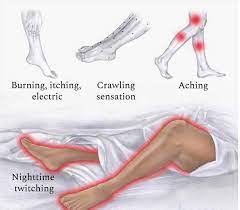
Restless legs syndrome (RLS), also called Willis Ekbom disease, affects 5-10 percent of adults in the United States. RLS causes “uncomfortable feelings in the legs, such as itching, prickling, pulling, or crawling. People with RLS may walk, stretch, or shake their legs to achieve relief. Symptoms tend to be worse when inactive, including when relaxing or lying down.”
With women suffering from RLS more than men, genetics between the first links of the patient to their parent or sibling is the leading link to this sleeping disorder. In severe cases, RLS is accompanied by insomnia when a patient cannot get control over the symptoms. But it can also tie into other medical conditions such as late-stage kidney disease, iron deficiency, multiple sclerosis, or Parkinson’s disease.
So how does one help prevent RLS or lower the cases? Today we will review the quality of sleep tied to your mattress, exercise, and hydration to help reduce instances and increase the quality of sleep.
Insomnia and Quality of Sleep
Insomnia affects 50-70 million Americans which includes only those seeking help and getting diagnosed. A lot that are diagnosed may be individuals who sleep a full seven or more hours but are not receiving a quality night’s sleep. What is the difference and how does quality matter? Quality is defined as the excellence of something or a distinctive attribute. Without a complete, quality-filled seven or eight hours, the sleep is unfortunately all for nothing.
Quality sleep is the difference between your FitBit showing spikes in restlessness or your spouse poking and prodding your side when you keep tossing and turning. And although we have all experienced a night or two with quality-lacking sleep, the majority of your 7 nights of rest each week should be restful and quality-rich.
Mattresses and Positions
Starting with the traditional choice is a mattress and box spring. A firm mattress can prove beneficial to those with ailing back problems. With a firmer surface, the bones absorb more of the pressure than a soft mattress which puts less stress on muscles and improves circulation. The lower back support within a firm mattress helps support the sagging weight of your body meaning your weight is more equally distributed.
If you prefer side sleeping, the cushion on the shoulders and hips better aligns on a soft mattress. It also helps better align the spine for those with chronic back pain. For heavier sleepers, a soft mattress can actually cause back issues for some sleepers.
Pillow tops contain an additional upholstery layer sewn onto the top of the mattress for a plusher sleep. Innerspring mattresses use a steel coil support system. Though many innersprings are designed differently, padding covers with individually wrapped pocketed coils are designed to contour to the bed support.
Latex mattresses are good for allergies as they are made from plant or petroleum-based materials. Memory foam uses a high-density polyurethane foam as the support system in the upper layer. Gel mattresses can offer comfort and heat dissipation features different from a traditional mattress.
For RLS specifically as the main sleeping disorder, memory foam mattresses or an adjustable bed, such as a Casper or Sleep Number, can help reduce the occurrences of RLS at night. Adjustable frames not only can prop up your back and head, but many can also adjust the angle of your feet and legs which increases the blood flow and circulation.
Exercise and Hydration
Exercise including yoga, meditation, or running can help unwind your anxiety and release the toxins clogging your mind and body. By pursuing the right mix of physical activity, a short 30 minutes creates the balance needed for a restful night and a clear conscience. According to the Sleep Foundation, a nationally representative sample of more than 2,600 men and women, ages 18-85, found that 150 minutes of moderate to vigorous activity a week “provided a 65 percent improvement in sleep quality.”
Paired with a healthy dose of exercise and healthy eating habits is proper hydration. With RLS, dehydration can be a leading cause of issues prior to bedtime so balancing your hydration throughout the day is key. Finding a sugar-free electrolyte drink like Powerade or Gatorade would also be a smart substitution to help increase hydration.
Stretching and lower-impact joint exercises like swimming have proven to help lessen the frequency of RLS episodes at bedtime. But remember: do not go too extreme with physical activity when suffering from RLS and try to add stretching to your daily routine.
If you have never been diagnosed or seen a doctor over your sleep quality, consider contacting The Alaska Sleep Clinic. This could be the reason for frequent RLS episodes so this free 10-minute phone call with a sleep educator can help determine if a sleep study is necessary or if a consultation with our sleep specialist needs to be scheduled.










